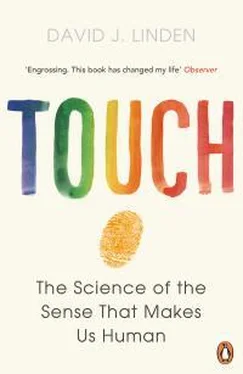11. Y.-G. Sun, Z.-Q. Zhao, X.-L. Meng, J. Yin, X. Y. Liu, and Z.-F. Chen, “Cellular basis of itch sensation,” Science 325 (2009): 1531–34. This line of work has been a bit confusing. Initially, these authors believed that GRP was the neurotransmitter of the sensory cells in the dorsal root ganglion that were the primary itch receptors. However, more recent evidence has indicated that these cells do not express GRP, and instead GRP is a neurotransmitter for the neurons in the spinal cord that receive itch signals from NPPB-releasing cells.
12. S. R. Wilson, K. A. Gerhold, A. Bifolck-Fisher, Q. Liu, K. N. Patel, X. Dong, and D. M. Bautista, “TRPA1 is required for histamine-independent, Mas-related G protein-coupled receptor-mediated itch,” Nature Neuroscience 14 (2011): 595–603.
13. Woody Guthrie wrote the lyrics to “Hesitating Beauty” and many other songs for which he never composed music. Years later, at the instigation of Woody’s daughter Nora, Billy Bragg and Wilco were recruited to compose tunes and perform some of these abandoned Guthrie songs. “Hesitating Beauty” received a tune and a fine performance from Jeff Tweedy and his band Wilco. You can read the complete lyrics at http://www.metrolyrics.com/hesitating-beauty-lyrics-wilco.html.
14. G. A. Bin Saif, A. D. Papoiu, L. Banari, F. McGlone, S. G. Kwatra, Y. H. Chan, and G. Yosipovitch, “The pleasurability of scratching an itch: a psychophysical and topographical assessment,” British Journal of Dermatology , EPUB ahead of print, 2012. In this experiment, the experimenter, not the subject, did the scratching in order to produce a constant intensity of scratching across subjects and skin areas. However, I can’t help but wonder if the results would have been different if the subjects had been able to scratch themselves. In general, subjects will scratch themselves much more vigorously than an experimenter will.
15. In one study, monkeys received a small injection of histamine in the skin to evoke an itchy sensation. This caused activation of neurons in the spinothalamic tract of the spinal cord that convey itch signals to the brain. When the skin region including the histamine injection site was scratched by the experimenter, this reduced the activation of these spinal cord neurons by histamine. In control experiments, scratching did not reduce the electrical activation of neurons in the spinal cord activated by pain or light touch. S. Davidson, X. Zhang, S. G. Khasabov, D. A. Simone, and G. J. Giesler Jr., “Relief of itch by scratching: state-dependent inhibition of primate spinothalamic tract neurons,” Nature Neuroscience 12 (2009): 544–46.
16. One interesting prediction of this evolutionary speculation is that those animals lacking the ability to scratch or otherwise dislodge insects or other parasites from the skin would possess fundamentally different itch-processing systems in the skin, spinal cord, and brain.
17. X.-Y. Liu, Z. C. Liu, Y.-G. Sun, M. Ross, S. Kim, F.-F. Tsai, Q.-F. Li, J. Jeffry, J.-Y. Kim, H. H. Loh, and Z.-F. Chen, “Unidirectional cross-activation of GPCR by MOR1D uncouples itch and analgesia induced by opioids,” Cell 147 (2011): 447–58.
18. A. Drzezga, U. Darsow, R. D. Treede, H. Siebner, M. Frisch, F. Munz, F. Weilke, G. Ring, M. Schwaiger, and P. Bartenstein, “Central activation by histamine-induced itch: analogies to pain processing: a correlational analysis of O 15H 2O positron emission tomography studies,” Pain 92 (2001): 295–305. More recent work has sought to dissociate the brain-response patterns to different types of itch: A. D. P. Papoiu, R. C. Coghill, R. A. Kraft, H. Wang, and G. Yosipovitch, “A tale of two itches. Common features and notable differences in brain activation induced by cowhage and histamine induced itch,” NeuroImage 59 (2012): 3611–26.
19. A. L. Oaklander, “Common neuropathic itch syndromes,” Acta Dermato-Venereologica 9 (2012): 118–25.
20. A. L. Oaklander, S. P. Cohen, and S. V. Y. Raju, “Intractable postherpetic itch and cutaneous deafferentation after facial shingles,” Pain 96 (2002): 9–12. This case was also explored by Atul Gawande in a splendid piece that appeared in the New Yorker and which I have mined for some details: A. Gawande, “The itch,” New Yorker, June 30, 2008, 58–65.
21. V. Niemeier, J. Kupfer, and U. Gieler, “Observations during an itch-inducing lecture,” Dermatology and Psychosomatics 1 (2000): 15–18.
22. D. M. Lloyd, E. Hall, S. Hall, and F. McGlone, “Can itch-related visual stimuli alone provide a scratch response in healthy individuals?” British Journal of Dermatology 168 (2012): 106–111. It turns out that, like socially contagious yawning, contagious itch is not restricted to humans. Here’s an interesting report of socially contagious itch in rhesus monkeys: A. N. Feneran, R. O’Donnell, A. Press, G. Yosipovitch, M. Cline, G. Dugan, A. D. P. Papoiu, L. A. Nattkemper, Y. H. Chan, and C. A. Shively, “Monkey see, monkey do: contagious itch in nonhuman primates,” Acta Dermato-Venereologica 93 (2013): 27–29.
23. H. Holle, K. Warne, A. K. Seth, H. D. Critchley, and J. Ward, “Neural basis of contagious itch and why some people are more prone to it,” Proceedings of the National Academy of Sciences of the USA 109 (2012): 19816–21.
24. André Gide, writing in his diary, March 19, 1931.
CHAPTER EIGHT: ILLUSION AND TRANSCENDENCE
1. M. J. Zigler, “An experimental study of the perception of clamminess,” American Journal of Psychology 34 (1923): 550–61. Clamminess is an odd sensation. Its unpleasantness seems to derive in part from associations with the flesh of dead homeothermic animals or living poikilothermic (cold-blooded) ones.
2. Oil from seeds of the plant Salvia hispanica .
3. I. M. Bentley, “The synthetic experiment,” American Journal of Psychology 11 (1900): 405–25. Bentley approached wetness perception using a very controlled situation in which the subject was not able to explore with his or her finger. In the real world, much of our perception of wetness using the hand involves active touch. More recently, experiments have been performed in which subjects are allowed to explore a wetted surface with the finger pad. In one of these, a particular signature of friction and acceleration (called stick slip) was found to be a reliable signature to distinguish water from thicker or greasy liquids. When stick-slip forces designed to mimic water were applied to the fingertip using a specially instrumented glass plate outfitted with ultrasonic stimulators, this could effectively simulate a water-coated surface. Subjects believed that the surface was wet even when it wasn’t. Y. Nonomura, T. Miura, T. Miyashita, Y. Asao, H. Shirado, Y. Makino, and T. Maeno, “How to identify water from thickener aqueous solutions by touch,” Journal of the Royal Society Interface 9 (1992): 1216–23.
4. There’s a great experiment in which a similar tit-for-tat scenario unfolded in the lab. Two adult subjects faced each other, each resting the left index finger, palm up, in a molded depression. A metal bar on a hinge was then rested on top of each subject’s finger. The hinge was outfitted with a sensor to measure the force delivered when the bar was pressed. Both subjects were given the same instructions: Exactly match the force of the tap on his finger that he receives with an equivalent tap when his turn comes. Neither subject knew the instructions given to the other. When the subjects took turns pressing on each other’s fingers, the force applied always escalated dramatically, just like Natalie and Jacob in the bathroom door game. Each person said that he matched the force of the other’s tap. When asked to guess the instructions given to the other person, each said, “You told the other person to press back twice as hard.” The experiment was then modified such that the tap was produced by moving a joystick that controlled a motorized bar. The key difference between these two situations is that when the force is generated by bar pressing, making a stronger tap requires generating more force with the fingertip, which is sensed by the tapper. Instead, when the joystick is used, the motor does the work and there is no correlation between the force generated by the joystick-controlling finger and the force produced on the upturned finger of the other subject. In this configuration there was no significant force escalation. S. S. Shergill, P. M. Bays, C. D. Frith, and D. M. Wolpert, “Two eyes for an eye: the neuroscience of force escalation,” Science 301 (2003): 187. This study is discussed in the context of cerebellar function in a previous book of mine: D. J. Linden, The Accidental Mind (Cambridge, MA: Harvard/Belknap Press, 1997),9–13. In these scenarios, estimation of force is not entirely dependent upon touch signals. Sensors in the joints and muscles also contribute.
Читать дальше












